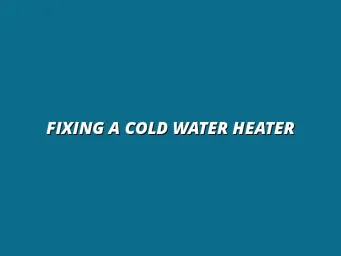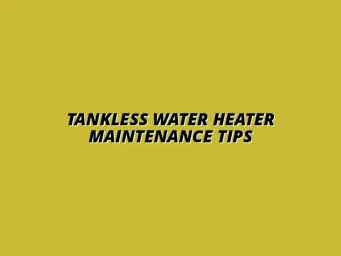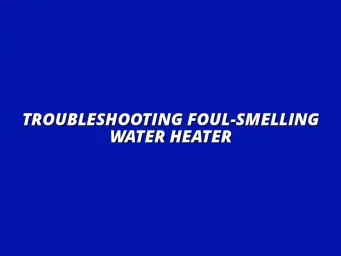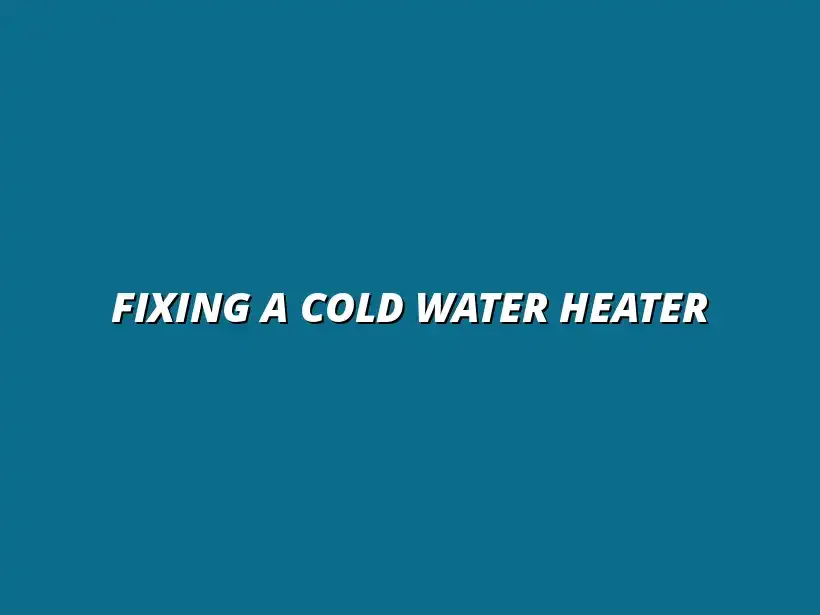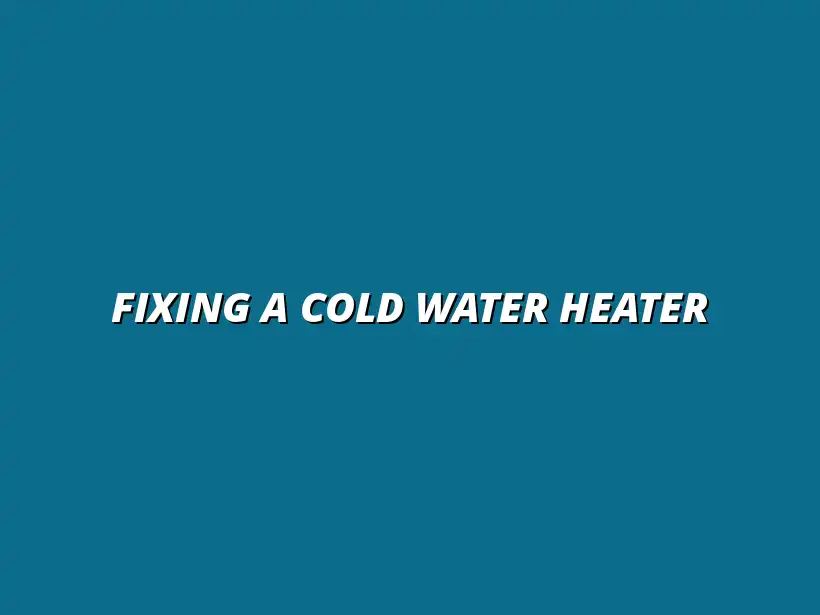
Fixing a Cold Water Heater
Understanding the Issue with Cold Water from Your Water Heater
Having a water heater that doesn't provide hot water can be frustrating! It’s important to understand the underlying issues that may cause this problem. By identifying the signs and causes, you can tackle the situation with confidence and resolve the issue efficiently.
Identifying the Signs of a Faulty Water Heater
There are several common indicators that can signal a malfunctioning water heater. If you notice temperature fluctuations or an inconsistent hot water supply, these could be red flags. Other signs might include unusual noises coming from the unit or leaks around the base. Ignoring these signs might lead to further complications, so it's best to act quickly, and you might want to consider preventative measures such as regular bathroom water heater checks to avoid unexpected issues.
- Temperature fluctuations when using hot water.
- Inconsistent hot water supply during showers or appliances.
- Unusual noises like popping or rumbling sounds.
- Visible leaks or moisture around the water heater.
Taking note of these signs can help you determine whether it's time to troubleshoot or call in a professional.
Common Causes of Cold Water Production in Water Heaters
Understanding why your water heater might be producing cold water is essential. Several factors can contribute to this issue, including sediment buildup, which can impede heating efficiency. Learning how to flush your water heater easily can significantly improve its performance. Other common causes include problems with the thermostat or failures in the heating elements.
- Sediment buildup in the tank.
- Malfunctioning thermostat settings.
- Heating element failures in electric models.
- Issues with gas supply or burner components in gas heaters.
By learning about these causes, you can begin diagnosing the problem and take appropriate steps to resolve it. Keeping your water heater maintained can significantly reduce the chances of these issues arising in the first place.
Step-by-Step Troubleshooting Guide for Cold Water Issues
Initial Safety Precautions Before Troubleshooting
Before diving into troubleshooting your water heater, it's crucial to prioritize safety. Make sure to turn off the power supply to the heater, either by unplugging it or switching off the circuit breaker. Additionally, check for any visible leaks or damage that could pose risks during repairs. Learning how to prevent water heater leaks easily is a crucial preventative measure.
- Turn off the power supply to the water heater.
- Shut off the water supply to prevent leaks.
- Wear protective gear, such as gloves and goggles.
Taking these precautions will help ensure you stay safe while addressing the issue! Remember, safety first, so you can focus on fixing the problem without any worries.
Checking the Thermostat Settings for Optimal Performance
Next, you’ll want to check the thermostat settings on your water heater. Most heaters have a simple dial or digital display that allows you to adjust the temperature. Make sure it is set to the recommended level, usually around 120°F (49°C) for optimal performance.
- Locate the thermostat on your water heater.
- Adjust the temperature if it is set too low.
- Wait a few hours and then test the hot water supply.
Making sure your thermostat is correctly set can make a world of difference when it comes to hot water availability. If adjustments don’t resolve the issue, you may need to dig deeper.
Inspecting the Heating Elements for Malfunctions
If checking the thermostat doesn’t yield results, it may be time to inspect the heating elements. In electric water heaters, there are usually two elements; upper and lower. You can test these elements using a multimeter to check for continuity. If you're facing a water heater that won't start, understanding how to fixing a water heater that won't start can be very helpful.
- Turn off the power and drain the water heater.
- Access the heating elements through the access panels.
- Use a multimeter to test for continuity.
Identifying a faulty heating element requires careful handling, but it’s an essential step in resolving cold water issues. If you discover that one is broken, replacing it can restore your hot water supply!
Cleaning and Flushing the Water Heater to Remove Sediment Buildup
Another critical step in troubleshooting is cleaning and flushing the water heater to remove any sediment buildup. Sediment can accumulate over time, affecting the heater's efficiency and performance. Flushing the tank can help restore its function. Regular maintenance, such as flushing, can greatly extend your water heater's lifespan.
- Turn off the power and water supply.
- Attach a hose to the drain valve at the bottom of the tank.
- Open the valve and let the water flow out until it runs clear.
- Close the valve and refill the tank.
Cleaning your water heater regularly can prevent future issues and prolong its life. It's a simple task that can lead to significant improvements in performance!
Evaluating the Anode Rod and Its Importance in Water Heater Functionality
The anode rod plays a vital role in protecting your water heater from corrosion. Over time, this rod can deteriorate, leading to increased tank corrosion and reduced hot water supply. Regularly checking the anode rod can help maintain your heater's efficiency. Understanding water heater leak causes and fixes is also essential for maintenance.
- Locate the anode rod, usually found at the top of the tank.
- Remove it and inspect for corrosion or damage.
- Replace it if it’s significantly corroded or depleted.
Keeping an eye on the anode rod can save you from costly repairs down the road. A little maintenance goes a long way!
Common Questions and Answers Regarding Cold Water Production
What should I do if my water heater starts producing cold water suddenly?
If you find yourself facing the issue of cold water from your heater unexpectedly, don’t panic! First, turn off the water heater to prevent any potential damage. Then, follow these immediate steps:
- Check the thermostat settings to ensure they are correctly set.
- Inspect for any visible leaks around the heater.
- Examine the power supply, ensuring the unit is receiving electricity.
- Consider resetting the unit, which might resolve minor glitches.
If these steps don’t restore your hot water, it may be time to delve deeper into potential issues, like sediment buildup or heating element failures. Always keep safety in mind!
Can sediment buildup cause my water heater to produce cold water?
Absolutely! Sediment buildup is one of the most common reasons for cold water issues in heaters. When sediment accumulates at the bottom of your tank, it can:
- Reduce the efficiency of the heating elements.
- Block hot water from circulating properly.
- Lead to overheating, which can cause the heater to shut off.
Regular flushing of your water heater can significantly mitigate this problem. This simple maintenance task ensures that your heater works efficiently, providing you with a consistent hot water supply!
Preventative Measures to Ensure Consistent Hot Water Supply
Regular Maintenance Routines for Water Heaters
To prevent cold water surprises, establishing a routine maintenance schedule is key! Here are some recommended practices:
- Flush the tank at least once a year to remove sediment buildup.
- Inspect the anode rod every couple of years, replacing it if necessary.
- Check for leaks and corrosion around the connections.
- Test the temperature and pressure relief valve annually to ensure it’s functioning correctly.
These tasks can help extend the lifespan of your heater and keep it running smoothly. By taking a proactive approach, you’ll minimize the chances of encountering cold water issues down the line. For more serious issues, consider contacting a plumber in Billesley, Birmingham.
Upgrading to Energy-Efficient Water Heaters for Better Performance
If your current water heater is older or frequently fails, it might be time to consider an upgrade. Modern, energy-efficient water heaters offer numerous benefits!
- Improved energy efficiency can lower your utility bills.
- Newer models often provide more consistent and faster hot water.
- Advanced technology can enhance safety features.
- Many are designed to require less maintenance.
Investing in a new water heater can save you money in the long run and ensure that you always have the hot water you need for your daily activities.
Final Thoughts and Next Steps
Summary of Key Steps to Fix Cold Water Issues
Addressing cold water issues involves a few key steps: first, assess your thermostat settings and inspect for any visible problems. Next, check the heating elements and consider flushing the tank to remove sediment buildup. Regular maintenance can help prevent these issues from reoccurring!
Encouragement to Take Action and Maintain Your Water Heater
Don’t wait for cold water surprises to motivate you! By implementing the tips discussed, you can keep your water heater in excellent shape. Remember, if the problems persist or become overwhelming, reaching out to a professional plumber is always a wise choice. Your comfort is worth it!
